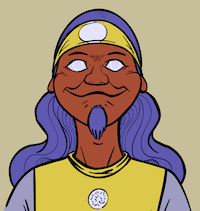A science fantasy Marco Polo-style voyage across a weird, old world.
UPDATE: The UVG Kickstarter is over. You can still get useful info from this post, for when the book comes out.
Hello there science fantasy lovers! Today I write about a very successful KS I backed, and that I’m very excited about, which is ending in a few days. Here is the breakdown, so you may get excited too ;)
When the Long Ago ended and the Now began
UVG is written and illustrated by Luka Rejec, a multi-talented designer, artist, and writer. You might know him for Witchburner, Deep in the Purple Worm or illustration work he did for Misty Isles of the Eld and What Ho, Frog Demons.
The Ultraviolet Grasslands (UVG) is a rules-light rpg pointcrawl module inspired by psychedelic heavy metal, the Dying Earth genre, and Oregon Trail games. It takes a group of ‘heroes’ into the depths of a vast and mythic steppe filled with the detritus of time and space and fuzzy riffs.
You can also download a free 78-page sample of the UVG book here.
Left End of the Right Road
What immediately drew my attention is the very imaginative science fantasy Luka writes. I got all kinds of Moebius vibes while reading it, and they are the best kind of vibes.
An old world at the edge of time. Humans of the later eras. Unkept technology and misremembered lore. Journey west into the unknown, and at the end of it all the Black City.
One could slot this right at the center of the Ninth World and it would be a fit.

Emptiness That Kills
This is, in essence, a caravan game. Players choose their starting links and backgrounds, a travel quest, and off they go. The challenge is that the UV Grasslands are really big. And quite empty. Weeks of travels are needed between locations. The map, which is a playable artifact that players can write on with all the locations and POIs listed, is about 5 pages long.
There are 4 main constraints around which the gameplay revolves. Time, Inventory, Supplies and Misfortune/Encounters.
The party gets a caravan sheet, on which they track all that, plus any henchmen, guards, animals, wagons, and all other expedition equipment they might have.
UVG is rules-light, descriptive and can be easily ported to any system. Here is an example of a creature block:
Deathmachine (HD 6, fast, lasers). Born of a mad ghost’s crucible, this steel and carbon golem has dragged pieces of flesh over its metal skeleton, and used the Ritual Preservation of Living Tissue to keep it from rotting away entirely.
Although a survival game, it takes extra care to properly abstract all the stuff that needs book-keeping, so it doesn’t become a bore for the players. A sack of supplies is an abstraction measure for all the food, water, gear, and other bits and pieces a human needs to survive for one week.
Ageless Spire of the Only Onager
The book provides great replay value as well. Each section is full of random tables that you can either roll on or just pick a cool entry.
One example is the factions. There are 8 main ones and each has a random table with rumors that give them a unique aspect. This is a clever way of laying out lore, as it allows a GM to suit it to their needs. One GM might take all rumors as canon, but others might roll once or a few times on a table and weave a story from just a few bits of information.
Great Biomechanical Baobab
Most of the book is filled with locations and this in itself is a great value. They are varied and strange, filled with incredible jewels of imagination.
There are 30 main locations and they come with maps, illustrations, weather, points of interests, directions, encounters, hooks, NPCs, mishap tables and what not.
Even if you never get to run UVG, one can just open a location and pop it straight into their science fantasy game. It’s that good.
Kickstarter
If you got the same vibes as I did reading this, check out the Kickstarter.


Comments